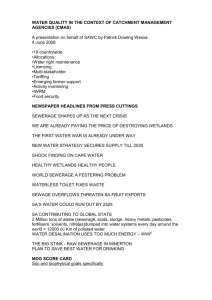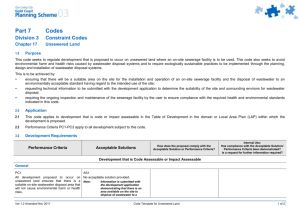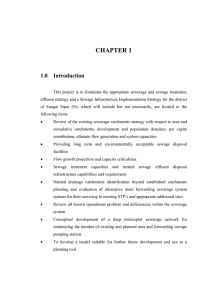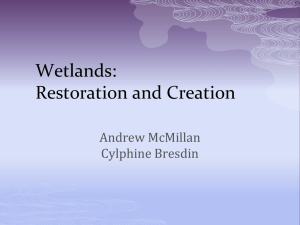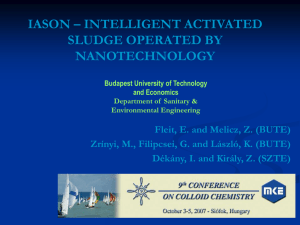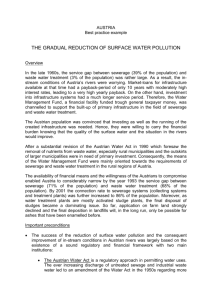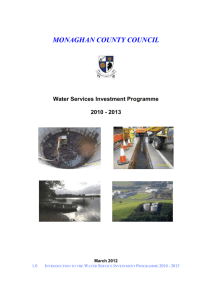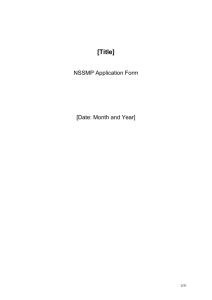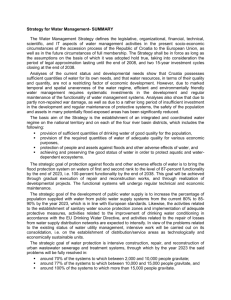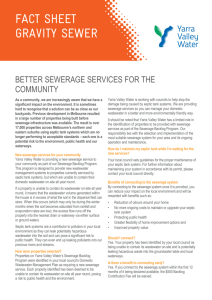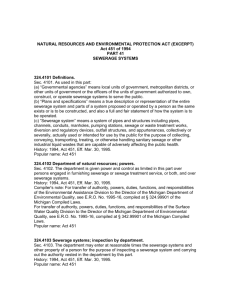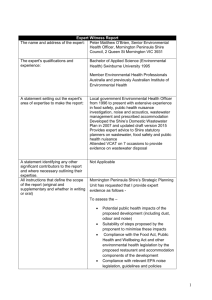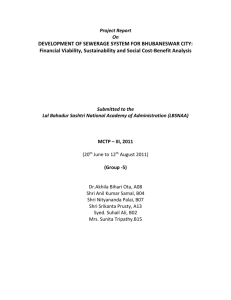Wetlands for treatment of wastewater
advertisement
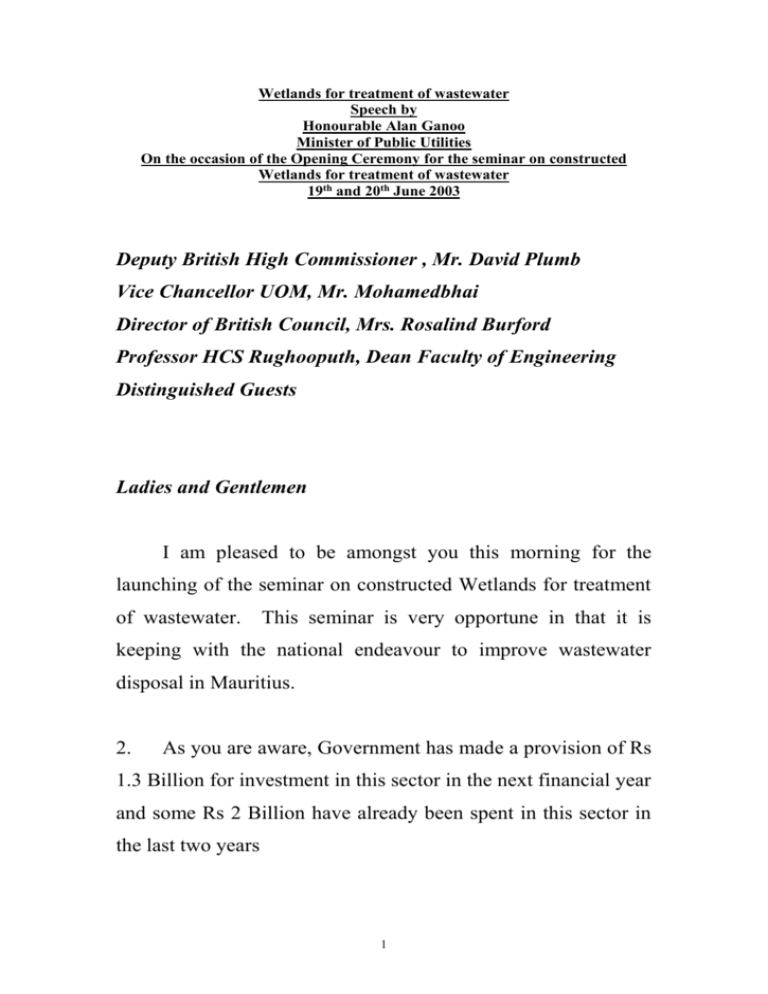
Wetlands for treatment of wastewater Speech by Honourable Alan Ganoo Minister of Public Utilities On the occasion of the Opening Ceremony for the seminar on constructed Wetlands for treatment of wastewater 19th and 20th June 2003 Deputy British High Commissioner , Mr. David Plumb Vice Chancellor UOM, Mr. Mohamedbhai Director of British Council, Mrs. Rosalind Burford Professor HCS Rughooputh, Dean Faculty of Engineering Distinguished Guests Ladies and Gentlemen I am pleased to be amongst you this morning for the launching of the seminar on constructed Wetlands for treatment of wastewater. This seminar is very opportune in that it is keeping with the national endeavour to improve wastewater disposal in Mauritius. 2. As you are aware, Government has made a provision of Rs 1.3 Billion for investment in this sector in the next financial year and some Rs 2 Billion have already been spent in this sector in the last two years 1 3. Massive investment in the wastewater sector is required as the level of connection has remained nearly at 20% over the years. In fact the Port Louis sewerage system dates more than one hundred years, while in the Plaine Wilhems the major part of the system was constructed decades ago. The risks associated with the low coverage of the sewer networks islandwide have been compounded by the major residential and industrial developments that have taken place in areas where we have most important aquifers. 4. Tremendous efforts are now required to catch up and, more importantly, to reverse the pollution trend before it becomes irreversible. .The National Sewerage Master Plan prepared in 1994 provides a guide for the orderly development of the wastewater sector over a period of twenty years. Recommendations made in the Master Plan encompass the financial, legislative, institutional, and technical aspects of the Wastewater sector. Based on the Master Plan more indepth institutional study was undertaken in 1997 for the operational setting up of an institution for the management of the sector, with a special focus on cost recovery. 5. The National sewerage programme has identified and prioritized the following projects to be implemented: 2 Montagne Jacquot, Grand Baie, Baie du Tombeau, Plaines Wilhems Reticulation systems and House connection, West Coast sewerage project, which mainly includes the Flic-en-Flac, Bambous and Tamarin for the collection, treatment and disposal of sewage in the West Coast Region. Upgrading of sewerage infrastructure on low-cost housing estates, and St. Martin treatment plant The total costs of these projects have been estimated to around Rs 11 billion for implementation by the year 2010. 6. The Baie du Tombeau Sewerage Project is now completed; whereas the Grand Baie Project is about 60% completed. The St. Martin Treatment Plant will be completed early next year. The next major project will be the Plaines Wilhems Sewerage Project estimated at around Rs 3.6 billion. This Project will comprise the construction of 27Km of trunk sewer in the regions 3 of Curepipe, Vacoas, Quatre Bornes, Rose Hill and Beau Bassin and 275 km of reticulation to connect some 35, 000 houses in these regions. Implementation of the project will start by the end of this year and will be completed in 2007. This project will be funded by various funding agencies, namely the European Union, the European Investment Bank, the African Development Bank and the Exim Bank of China. Much ground has been covered in the elaboration of yet another major project; it is that of Montagne Jacquot Treatment Plant. The contracts for both the setting up of the plant and the sea outfall will be awarded shortly. Government will now consider as a priority the implementation of sewerage systems in the western region of the country. In this connection, the feasibility study is nearing completion. 7. In addition to the major projects Government will continue to rehabilitate sewerage systems on CHA and low cost housing estates to improve living conditions generally. Some Rs 38.0 M have already been invested and in the next financial year, the 4 Government will invest some Rs 85.0 M for the upgrading of sewer systems in nine housing estates. Ladies and Gentlemen 8. There has been considerable delay in the development of sewer systems island-wide and today we have to invest massively in that sector to improve health and sanitary conditions of the population. However, there is a price to pay for the protection of our environment and all stakeholders should contribute in the massive investment required to implement the national sewerage programme in order not to jeopardize the environment for future generation. 9. Despite the magnitude of investment in the sewerage systems, many areas around the island will still be un-sewered and rely on on-site disposal systems. However, the use of onsite disposal such as septic tanks is unfortunately often ineffective due to constraints such as high water table, poor soil characteristics with low infiltration rate amongst others. Ladies and Gentlemen 10. Artificial or constructed wetlands are a potential viable onsite disposal system designed for wastewater treatment that 5 would not have the above constraints of classical on-site disposal systems. 11. This disposal method had received considerable attention since the late seventies in many developed countries in Europe, United States and Australia. Furthermore, many third world countries have used wetland systems for the treatment of domestic wastewater. Ladies and Gentlemen 12. I am advised that although the treatment mechanisms taking place in wetland systems have been studied, yet there is still a great deal to be learnt and understood concerning the very complex reactions taking place within the artificial wetland system. Moreover a lack of understanding of the factors influencing the behaviour of the system and the impact of climatic conditions have been the main reasons attributed to the variable degree of success recorded relative to confirm design criteria in several countries. 13. Despite the imponderables, artificial wetland systems nevertheless have a place in wastewater treatment technology. They are not suitable to treat raw wastewater in many instances 6 but can be used successfully to treat raw wastewater which has been subjected to primary treatment. 14. I have seen from the programme of the seminar that many issues pertaining to the artificial wetland system would be the subject of discussions and it is highly desirable that all pertinent issues relating to constructed wetlands be addressed. 15. Moreover, the application of the system in Mauritius should consider other aspects such as: (i) Compliance with water quality standards, (ii) Relative advantages/disadvantages of wetland and method of vector control (iii) Cost-effectiveness, (iv) Transfer and acceptability of the technology to users constructed Ladies and Gentlemen 16. I wish you deliberate on the above issues that are important for any future use of the constructed wetlands method of on-site disposal in Mauritius. 7 17. I declare the seminar open and wish you successful and fruitful deliberations. 8
